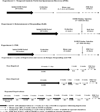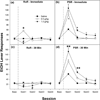Parameters of Context-Induced Ethanol (EtOH)-Seeking in Alcohol-Preferring (P) Rats: Temporal Analysis, Effects of Repeated Deprivation, and EtOH Priming Injections
- PMID: 27696522
- PMCID: PMC5055075
- DOI: 10.1111/acer.13205
Parameters of Context-Induced Ethanol (EtOH)-Seeking in Alcohol-Preferring (P) Rats: Temporal Analysis, Effects of Repeated Deprivation, and EtOH Priming Injections
Abstract
Background: Drug-paired environments can act as stimuli that elicit drug craving. In humans, drug craving is influenced by the amount of time abstinent, number of past periods of abstinence, and inadvertent exposure to the previously abused drug. The current experiments were designed to determine the effects of (i) the duration of abstinence on expression of ethanol (EtOH)-seeking; (ii) EtOH priming following a short and long abstinence period; and (iii) repeated deprivation cycles on relapse drinking and EtOH-seeking.
Methods: Rats were allowed to self-administer 15% EtOH, processed through extinction training, maintained in a home cage for a designated EtOH-free period, and then reintroduced to the operant context in the absence of EtOH. The experiments examined the effects of: (i) various home-cage duration periods (1 to 8 weeks), (ii) priming injections of EtOH in the Pavlovian spontaneous recovery (PSR; 14 days after extinction) and reinstatement of responding (RoR; 1 day after extinction) models, and (iii) exposure to repeated cycles of EtOH access-deprivation on relapse drinking and EtOH-seeking behavior.
Results: Highest expression of EtOH-seeking was observed following 6 weeks of home-cage maintenance. Priming injections of EtOH were more efficacious at stimulating/enhancing EtOH-seeking in the PSR than RoR model. Exposure to repeated cycles of EtOH deprivation and access enhanced and prolonged relapse drinking and the expression of EtOH-seeking (318 ± 22 responses), which was not observed in rats given equivalent consistent exposure to EtOH (66 ± 11 responses).
Conclusions: Overall, the data indicated that the PSR model has ecological validity; factors that enhance EtOH craving in humans enhance the expression of EtOH-seeking in the PSR test. The data also detail factors that need to be examined to determine the biological basis of EtOH-seeking (e.g., neuroadaptations that occur during the incubation period and following repeated cycles of EtOH drinking and abstinence).
Keywords: Alcohol Relapse; Alcohol-Preferring (P) Rats; Alcohol-Seeking Behavior; Repeated Alcohol Deprivations.
Copyright © 2016 by the Research Society on Alcoholism.
Conflict of interest statement
None of the authors has a conflict of interest associated with this research.
Figures







Similar articles
-
Conditioned stimuli affect ethanol-seeking by female alcohol-preferring (P) rats: the role of repeated-deprivations, cue-pretreatment, and cue-temporal intervals.Psychopharmacology (Berl). 2019 Sep;236(9):2835-2846. doi: 10.1007/s00213-019-05264-6. Epub 2019 May 16. Psychopharmacology (Berl). 2019. PMID: 31093721 Free PMC article.
-
Effects of ethanol exposure on subsequent acquisition and extinction of ethanol self-administration and expression of alcohol-seeking behavior in adult alcohol-preferring (P) rats: II. Adult exposure.Alcohol Clin Exp Res. 2002 Nov;26(11):1642-52. doi: 10.1097/01.ALC.0000036302.73712.9D. Alcohol Clin Exp Res. 2002. PMID: 12436052
-
The long-lasting effects of JDTic, a kappa opioid receptor antagonist, on the expression of ethanol-seeking behavior and the relapse drinking of female alcohol-preferring (P) rats.Pharmacol Biochem Behav. 2012 Jun;101(4):581-7. doi: 10.1016/j.pbb.2012.03.006. Epub 2012 Mar 10. Pharmacol Biochem Behav. 2012. PMID: 22429993 Free PMC article.
-
Animal Models of Drug Relapse and Craving after Voluntary Abstinence: A Review.Pharmacol Rev. 2021 Jul;73(3):1050-1083. doi: 10.1124/pharmrev.120.000191. Pharmacol Rev. 2021. PMID: 34257149 Free PMC article. Review.
-
Forced abstinence model of relapse to study pharmacological treatments of substance use disorder.Curr Drug Abuse Rev. 2009 May;2(2):184-94. doi: 10.2174/1874473710902020184. Curr Drug Abuse Rev. 2009. PMID: 19630748 Free PMC article. Review.
Cited by
-
Spontaneous Early Withdrawal Behaviors after Chronic 24-hour Free-Choice Access to Ethanol.Alcohol Alcohol. 2020 Aug 14;55(5):480-488. doi: 10.1093/alcalc/agaa040. Alcohol Alcohol. 2020. PMID: 32484507 Free PMC article.
-
A deeper insight into how GABA-B receptor agonism via baclofen may affect alcohol seeking and consumption: lessons learned from a human laboratory investigation.Mol Psychiatry. 2021 Feb;26(2):545-555. doi: 10.1038/s41380-018-0287-y. Epub 2018 Oct 31. Mol Psychiatry. 2021. PMID: 30382188 Free PMC article. Clinical Trial.
-
Conditioned stimuli affect ethanol-seeking by female alcohol-preferring (P) rats: the role of repeated-deprivations, cue-pretreatment, and cue-temporal intervals.Psychopharmacology (Berl). 2019 Sep;236(9):2835-2846. doi: 10.1007/s00213-019-05264-6. Epub 2019 May 16. Psychopharmacology (Berl). 2019. PMID: 31093721 Free PMC article.
-
Evidence for incentive salience sensitization as a pathway to alcohol use disorder.Neurosci Biobehav Rev. 2019 Dec;107:897-926. doi: 10.1016/j.neubiorev.2019.10.009. Epub 2019 Oct 28. Neurosci Biobehav Rev. 2019. PMID: 31672617 Free PMC article. Review.
-
Effect of repeated abstinence on chronic ethanol self-administration in the rhesus monkey.Psychopharmacology (Berl). 2018 Jan;235(1):109-120. doi: 10.1007/s00213-017-4748-9. Epub 2017 Oct 19. Psychopharmacology (Berl). 2018. PMID: 29051997 Free PMC article.
References
-
- Bienkowski P, Rogowski A, Korkosz A, Mierzejewski P, Radwanska K, Kaczmarek L, Bogucka-Bonikowska A, Kostowski W. Time-dependent changes in alcohol-seeking behaviour during abstinence. Eur Neuropsychopharmacol. 2004;14:355–360. - PubMed
-
- Bouton ME. Context, ambiguity, and unlearning: sources of relapse after behavioral extinction. Biol Psychiatry. 2002;52:976–986. - PubMed
-
- Bouton ME. Context and behavioral processes in extinction. Learn Mem. 2004;11:485–494. - PubMed
-
- Brooks DC. Recent and remote extinction cues reduce spontaneous recovery. Q J Exp Psychol B. 2000;53:25–58. - PubMed
Publication types
MeSH terms
Grants and funding
LinkOut - more resources
Full Text Sources
Other Literature Sources
Medical
Miscellaneous

